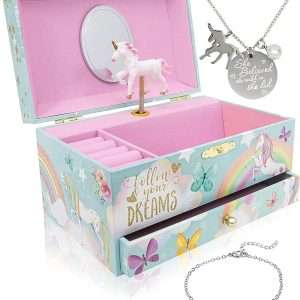Children's Jewelry Boxes
The Memory Building Company Musical Jewelry Box – Birthday Gifts and Toys for Kids
The Evolution of Music: How Genres Have Transformed Through the Decades
Music has been a powerful force, shaping our cultures and emotions over the decades. Each era brought new sounds, styles, and movements that defined the times and influenced generations to come. From the birth of rock and roll to today’s genre-blurring hits, music’s evolution is a fascinating journey filled with creativity and innovation.
As we dive into this rhythmic timeline, we’ll explore how various genres emerged and transformed—each embodying the spirit of its time while paving the way for what was next. Whether reminiscing about disco nights or vibing to modern beats, each musical style tells a story worth hearing. Grab your earbuds as we take an auditory trip through history!
The Birth of Rock and Roll in the 1950s
The 1950s marked a seismic shift in the music landscape with the birth of rock and roll. This electrifying blend of rhythm and blues, country, and jazz captured the hearts of young people everywhere. Artists like Elvis Presley became cultural icons, embodying both rebellion and charisma.
This genre provided an outlet for youth culture, breaking away from traditional norms. Dance halls were excited as teenagers listened to catchy tunes about their experiences.
Guitars roared while drums thumped, creating a sound that resonated deeply across different demographics. Rock and roll’s influence seeped into fashion, too—leather jackets and blue jeans became symbols of this musical revolution.
As it spread beyond America’s borders, rock music set the stage for countless subgenres, forever changing how we perceive rhythm and expression in popular culture.
The Rise of Pop Music in the 1960s
The 1960s marked a vibrant shift in the music landscape. Pop music blossomed, fueled by cultural revolutions and new technologies.
Artists like The Beatles and The Supremes captivated audiences with their catchy melodies and fresh lyrics. This era saw an explosion of creativity that set the stage for modern pop.
Television became a powerful medium. Shows like “American Bandstand” propelled artists into stardom overnight, making music accessible to millions.
Girl groups emerged, bringing unique harmonies and styles to the forefront. Their influence was undeniable, shaping future generations of female artists.
During the decade, she also embraced experimentation. Genres began to blend, giving rise to both innovative and timeless sounds.
From Motown’s infectious rhythms to folk-infused pop anthems, this period defined what it meant to be popular in music—and its echoes can still be felt today across all genres.
Disco Fever: The Dominance of Disco in the 1970s
The 1970s was a vibrant era that pulsated with the beat of disco. Nightclubs became havens for dance enthusiasts, each floor alive with rhythm and flashing lights. Artists like Bee Gees, Donna Summer, and Gloria Gaynor ruled the airwaves.
Disco wasn’t just music; it was a cultural phenomenon. It brought together diverse crowds and encouraged self-expression through fashion and movement. Bell bottoms, sequins, and platform shoes defined style and confidence on the dance floor.
Movies like “Saturday Night Fever” catapulted disco into mainstream culture. The soundtrack became iconic—everyone wanted to groove to those infectious melodies.
As disco spread across the globe, it influenced countless genres that followed. Its legacy is still felt today in electronic dance music and pop hits. That unmistakable bass line inspires new generations of artists eager to capture its magic.
From Hair Bands to Grunge: The 1980s and 1990s
The 1980s exploded with the glitz and glam of hair bands. Groups like Bon Jovi and Poison reigned supreme with towering hairstyles and leather outfits. Their catchy hooks and anthemic choruses captured a generation yearning for fun.
As the decade waned, a seismic shift occurred. The grunge movement emerged from Seattle, bringing raw honesty to music. Bands like Nirvana and Pearl Jam stripped away the excesses of rock’s earlier years.
This new sound resonated deeply with disenchanted youth. Lyrics turned introspective, addressing themes of alienation and angst. Suddenly, flannel shirts replaced spandex pants as fashion statements.
Listeners craved authenticity over artifice. Music videos showcased gritty realities instead of polished performances. The cultural landscape transformed rapidly during this period, setting the stage for diverse genres that would follow in subsequent decades.
Hip Hop Takes Center Stage in the 2000s
The 2000s marked a seismic shift in the music industry as hip-hop surged to prominence. Artists like Jay-Z, Eminem, and Missy Elliott redefined the genre, blending street narratives with catchy beats that appealed to mainstream audiences.
This era saw collaborations across genres, making hip-hop accessible to diverse listeners. Tracks often featured pop stars or rock musicians, creating unforgettable crossovers. The sound was fresh; it pulsated with energy and authenticity.
Lyricism became more prosperous and more complex. Rappers tackled social issues while sharing personal stories that resonated deeply with fans. This authenticity fostered an emotional connection many never experienced before.
As technology advanced, so did distribution methods. Platforms like YouTube enable artists to showcase their talent directly to global audiences without traditional gatekeepers.
Hip-hop is no longer just music; it has evolved into a cultural movement that influences fashion, language, and even lifestyle choices around the world.
The Current State of Music: Blurring Genre Lines in
Music today is a vibrant tapestry woven together by countless influences and styles. The digital age has transformed how we create, share, and consume music. With platforms like Spotify and Apple Music, listeners can access an infinite library at their fingertips.
Genres are no longer rigid categories but fluid concepts. Artists blend elements from various genres to craft unique sounds that defy traditional labels. For instance, pop artists may incorporate hip-hop beats or country undertones into their tracks, producing fresh compositions that appeal to broad audiences.
Collaborations across different musical styles have become commonplace. This fusion leads to innovative works that resonate with fans of all backgrounds. The boundaries between genres continue to blur as new generations embrace this eclectic approach.
Moreover, the rise of social media has propelled niche genres into the spotlight overnight. What was once underground can quickly gain mainstream attention through viral trends on platforms like TikTok or Instagram.
As we navigate this era of musical evolution, it’s clear that creativity knows no bounds. Listeners are encouraged to explore beyond conventional labels and discover a world filled with rich diversity in sound—echoing the sentiment behind those charming music boxes for girls and boys: each one tells a story worth hearing.


